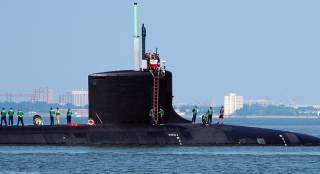Report: U.S. Navy Needs More Nuclear Attack Submarines and Smaller Aircraft Carriers
And the reason is clear: China.
The CSBA does not recommend the U.S. abandon its carrier-centric force altogether, but says the Navy needs to focus more on submarines and calls for a resurgence of the surface fleet. The report also calls for a new smaller carrier-sized ship.
The Pentagon and the U.S Navy must increase submarines, strengthen the surface fleet size and build new smaller, more agile carrier-type ships -- as as part of a broader effort to rethink the way it constructs the American fleet for future conflicts and operations, the Center for Strategic and Budgetary Assessment (CSBA) contends in a just-released report.
“Today’s approach of using large, high-end platforms such as aircraft carriers to support the whole range of naval operations will not be effective at providing the prompt, survivable, high-capacity firepower that might be required to deter aggression in the South or East China Seas,” CSBA says in its report, CSBA “Restoring American Seapower, A New Fleet Architecture for The United States Navy,” released Feb. 9.
The CSBA does not recommend the U.S. abandon its carrier-centric force altogether, but says the Navy needs to focus more on submarines and calls for a resurgence of the surface fleet. The report also calls for a new smaller carrier-sized ship.
“It may be better to rely upon submarines and surface combatants as the primary instruments of deterrence and reassurance and deploy aircraft carriers from the open ocean where they can maneuver to engage the enemy once aggression occurs,” CSBA says.
While the study does not call for a decrease in the current numbers of carriers, it does maintain that smaller, more maneuverable type carriers might make certain high-risk missions more plausible in light of emerging threats such as long-range anti-ship missiles and enemy coastal defenses.
The report cites growing international naval competition as a reason for altered strategy.
“Today the PLA (People’s Liberation Army) Navy (PLAN) boasts the second largest fleet in the world, with a large portion of ships built in the last decade. The PLA includes a rapidly modernizing air force in addition to a Rocket Force (formerly the Second Artillery Corps) that deploys a wide array of conventional land-attack and anti-ship ballistic missiles (ASBM) as well as the country’s nuclear arsenal,” CSBA notes.
“Combined with China’s long-range surveillance network of satellites and shore-based radars and sensors, these forces create a formidable reconnaissance-strike complex that can threaten U.S. and allied forces on or above the water hundreds of miles from China’s borders,” the report says.
The old nuclear trump card may come up short now, too.
“An American nuclear response would likely further damage the international and political systems upon which American prosperity depends,” CSBA says.
“Therefore, adversaries may no longer find U.S. nuclear deterrence to be credible in these situations, making effective conventional deterrence necessary.”
A return, the CSBA says, to the “deny-and-punish” approach used during the Cold War to deterrence will increase America’s reliance on forward-postured forces—particularly naval forces.
“American aircraft, troops, ships, sensors, and weapons would need to be postured in proximity to a likely area of confrontation,” CSBA says. “The United States, and U.S. naval forces in particular, will need to return to their Cold War deterrence concept of denying an aggressor’s success or immediately punishing the aggressor to compel it to stop. Compared to the Cold War, however, naval forces in the 2030s will face a more challenging threat environment and more constrained timelines. They will have to adopt new operational approaches to deter under these conditions.”
But, CSBA says, the current strategy remains focused on “efficiently sustaining forward presence rather than posturing and preparing forces to deter and respond to great power aggression.”
A new course will require more than just altered thinking.
CSBA recommends a “$640 billion base national defense budget (including Department of Energy nuclear activities) in Fiscal Year 2018, which is $54 billion above (former) President Obama’s planned budget. Over five years, this plan represents a $430 billion increase above current plans/”
CSBA says, “These recommendations should be regarded as reasoned estimates.
Today, the U.S. Navy is 274 ships. This was already short of the joint force requirement of 308 ships. And that was before the Chief of Naval Operations announced that the Navy should grow to 355 ships to address the growing fleet sizes and capabilities of our adversaries.”
Whatever the right fleet size ultimately is, CSBA says, the “key objective for the next five years is the same: The Navy must ramp up shipbuilding. It is unrealistic to deliver 81 ships by 2022.”
This first appeared in Scout Warrior here.

